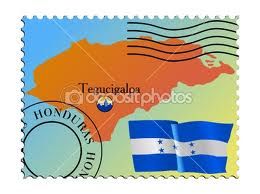Statistics
Location: 15 00 N, 86 30 W -- Middle America, bordering the Caribbean Sea, between Guatemala and Nicaragua and bordering the North Pacific Ocean, between El Salvador and Nicaragua
Flag
Description: three equal horizontal bands of blue (top), white, and blue with five blue five-pointed stars arranged in an X pattern centered in the white band; the stars represent the members of the former Federal Republic of Central America - Costa Rica, El Salvador, Guatemala, Honduras, and Nicaragua; similar to the flag of El Salvador, which features a round emblem encircled by the words REPUBLICA DE EL SALVADOR EN LA AMERICA CENTRAL centered in the white band; also similar to the flag of Nicaragua, which features a triangle encircled by the word REPUBLICA DE NICARAGUA on top and AMERICA CENTRAL on the bottom, centered in the white band
Honduras Geography
Location Middle America, bordering the Caribbean Sea, between Guatemala and Nicaragua and bordering the North Pacific Ocean, between El Salvador and Nicaragua
Geographic coordinates 15 00 N, 86 30 W
Centra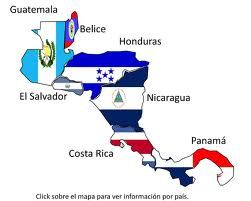 l America and the Caribbean Area
l America and the Caribbean Area
total: 112,090 sq km, land: 111,890 sq km, water: 200 sq km
Area - comparative: slightly larger than Tennessee
Land boundaries: total: 1,520 km
border countries: Guatemala 256 km, El Salvador 342 km, Nicaragua 922 km
Coastline: 820 km Maritime claims: contiguous zone: 24 NM, territorial sea: 12 NM
continental shelf: natural extension of territory or to 200 NM
exclusive economic zone: 200 NM
Climate subtropical in lowlands, temperate in mountains
Terrain
Mostly mountains in interior, narrow coastal plains Elevation extremes: lowest point: Caribbean Sea 0 m
highest point: Cerro Las Minas 2,870 m
Natural resources timber, gold, silver, copper, lead, zinc, iron ore, antimony, coal, fish, hydropower 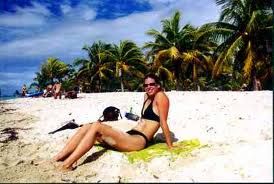
Land use arable land: 15.15%, permanent crops: 3.13%, other: 81.72% (1998 est.), Irrigated land: 760 sq km (1998 EST.)
Natural hazards frequent, but generally mild, earthquakes; extremely susceptible to damaging hurricanes and floods along the Caribbean coast
Environment - current issues: urban population expanding; deforestation results from logging and the clearing of land for agricultural purposes; further land degradation and soil erosion hastened by uncontrolled development and improper land use practices such as farming of marginal lands; mining activities polluting Lago de Yojoa (the country's largest source of fresh water) as well as several rivers and streams with heavy metals
Environment - international agreements
Party to: Biodiversity, Climate Change, Climate Change-Kyoto Protocol, Desertification, Endangered Species, Hazardous Wastes, Law of the Sea, Marine Dumping, Nuclear Test Ban, Ozone Layer Protection, Ship Pollution, Tropical Timber 83, Tropical Timber 94, Wetlands signed, but not ratified: none of the selected agreements
GANE DINERO POR LA RED
Imports: $2.7 billion f.o.b. (2001 est.)
Imports - commodities: machinery and transport equipment, industrial raw materials, chemical products, fuels, foodstuffs
Imports - partners: US 46.1%, Guatemala 8.2%, El Salvador 6.6%,Mexico 4.7%, Japan 4.6% (2000)
Debt - external: $5.6 billion (2001)
Economic aid - recipient: $557.8 million (1999)
Currency: lempira Currency code: HNL
Exchange rates: lempiras per US dollar - 16.0256 (January 2002), 15.9197 (2001), 15.1407 (2000), 14.5039 (1999), 13.8076 (1998), 13.0942 (1997) Fiscal year: calendar year
Communications in Honduras
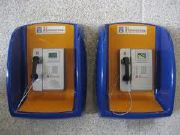
Telephones - main lines in use: 234,000 (1997)
Telephones - mobile cellular: 14,427 (1997)
Telephone system: general assessment: inadequate system
International: satellite earth stations - 2 Intelsat (Atlantic Ocean); connected to Central American Microwave System
Radio broadcast stations: AM 241, FM 53, shortwave 12 (1998)
Radios: 2.45 million (1997)
Television broadcast stations: 11 (plus 17 repeaters) (1997)
Televisions: 570,000 (1997)
Internet country code: .hn
Internet Service Providers (ISPs): 8 (2000)
Internet users: 40,000 (2000)
Transportation
Railways: total: 595 km narrow gauge: 318 km 1.067-m gauge; 277 km 0.914-m gauge (2000)
Highways: total: 15,400 km, paved 3,126 km, unpaved 12,274 km (1999 EST.)
Waterways: 465 km (navigable by small craft)
Ports and harbors: La Ceiba, Puerto Castilla, Puerto Cortes, San Lorenzo, Tela, Puerto Lempira
Merchant marine: total: 284 ships (1,000 GRT or over) totaling 749,243 GRT/846,942 DWT note: includes some foreign-owned ships registered here as a flag of convenience: Argentina 1, Bahrain 1,Belize, British Virgin Islands 1, Bulgaria 1, China 8, Costa Rica 1, Cyprus 1, Egypt 6, El Salvador 1.
Germany 1, Greece 18, Hong Kong 3, Indonesia 2, Italy 1, Japan 7, Lebanon 4, Liberia 4, Maldives 2, Marshall Islands 1, Mexico 1, Nigeria 1,  Norway 1, Panama 14, Philippines 1, Romania 2, Russia 1, Saint Kitts and Nevis 3, Saint Vincent and the Grenadines 1.
Norway 1, Panama 14, Philippines 1, Romania 2, Russia 1, Saint Kitts and Nevis 3, Saint Vincent and the Grenadines 1.
Singapore 24, South Korea 12, Spain 1, Syria 1, Taiwan 4, Tanzania 1, Trinidad and Tobago 1, Turkey 2, Turks and Caicos Islands 1, United Arab Emirates 6, United Kingdom 1, United States 5, Vanuatu 1, Vietnam 1, Virgin Islands (UK) 1 (2002 est.)
ships by type: bulk 20, cargo 166, chemical tanker 5, container 6, livestock carrier 1, passenger 3, passenger/cargo 3, petroleum tanker 54, refrigerated cargo 12, roll on/roll off 8, short-sea passenger 4, specialized tanker 1, vehicle carrier 1
Airports: 117 (2001)
Airports - with paved runways: total: 12
2,438 to 3,047 m: 3
1,524 to 2,437 m: 2
914 to 1,523 m: 3
under 914 m: 4 (2002)
Airports - with unpaved runways:
total: 103
1,524 to 2,437 m: 2
914 to 1,523 m: 18
under 914 m: 83 (2002)
Honduran Military
Military branches: Army, Navy (including marines), Air Force 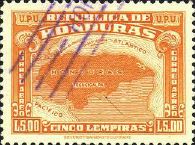
Military manpower - military age: 18 years of age (2002 EST.)
Military manpower - availability: males age 15-49: 1,563,174 (2002 EST.)
Military manpower - fit for military service: males age 15-49: 930,718 (2002 EST.)
Military manpower - reaching military age annually: males: 72,335 (2002 EST.)
Military expenditures - dollar figure: $35 million (FY99)
Military expenditures - percent of GDP: 0.6% (FY99)
Transnational Issues
Disputes - international: Honduras claims Sapodilla Cays off the coast of Belize; El Salvador disputes tiny Conejo Island off Honduras in the Golfo de Fonseca; many of the "bolsones" (disputed areas) along the El Salvador-Honduras boundary remain undemarcated despite ICJ adjudication in 1992; with respect to the maritime boundary in the Golfo de Fonseca, the ICJ referred to the line determined by the 1900 Honduras-Nicaragua Mixed Boundary Commission and advised a tripartite resolution among El Salvador, Honduras, and Nicaragua.
Nicaragua filed a claim against Honduras in 1999 and against Colombia in 2001 at the ICJ over disputed maritime boundary involving 50,000 sq km in the Caribbean Sea, including the Archipelago de San Andres y Providencia and Quita Sueno Bank
Illicit drugs: transshipment point for drugs and narcotics; illicit producer of cannabis, cultivated on small plots and used principally for local consumption; corruption is a major problem; some money-laundering activity.
Population
|
Population: |
7,833,696 (2009 est.) |
|
Age structure: |
0-14 years: 39.9% (male 1,491,170/female 1,429,816) |
|
Median age: |
19.5 years |
|
Growth rate: |
2.16% |
|
|
25.82 deaths/1,000 live births |
|
Life expectancy at birth: |
total population: 69.33 years |
|
Fertility rate: |
3.59 children born/woman |
|
Nationality: |
noun: Honduran(s) |
|
|
mestizo (mixed Amerindian and European) 90%, Amerindian 7%, black 2%, white 1% |
|
Religions: |
Roman Catholic 97%, Protestant minority |
|
Languages: |
Spanish, Amerindian dialects |
|
Literacy: |
definition: age 15 and over can read and write |
Country name: Republic of Honduras
Government type: Democratic Constitutional Republic
Capital: Tegucigalpa
Administrative divisions: 18 departments (departamentos, singular - departamento); Atlántida, Choluteca, Colon, Comayagua, Copan, Cortes, El Paraiso, Francisco Morazán, Gracias a Dios, Intibucá, Islas de la Bahia, La Paz, Lempira, Ocotepeque, Olancho, Santa Barbara, Valle, Yoro
Independence: September 15, 1821 (from Spain)
Constitution: 11 January 1982, effective 20 January 1982; amended 2005
Legal system: rooted in Roman and Spanish civil law with increasing influence of English common law; recent judicial reforms include abandoning Napoleonic legal codes in favor of the oral adversarial system; accepts ICJ jurisdiction, with reservations
Suffrage: 18 years of age; universal and compulsory
Cabinet: Cabinet appointed by president
Elections: president elected by popular vote for a four-year term;
Legislative branch:
National Congress or Congreso Nacional (128 seats; members are elected proportionally to the number of votes their party's presidential candidate receives to serve four-year terms)
Political parties:
Christian Democratic Party or PDC;
Democratic Unification Party or PUD;
Liberal Party or PL;
National Innovation and Unity Party-Social Democratic Party or PINU-SD;
National Party of Honduras or PN.
Political pressure groups:
Committee for the Defense of Human Rights in Honduras or CODEH;
Confederation of Honduran Workers or CTH;
Coordinating Committee of Popular Organizations or CCOP;
General Workers Confederation or CGT;
Honduran Council of Private Enterprise or COHEP;
Nati onal Association of Honduran Campesinos or ANACH;
onal Association of Honduran Campesinos or ANACH;
National Union of Campesinos or UNC;
Popular Bloc or BP;
United Federation of Honduran Workers or FUTH
International organization participation:
BCIE, CACM, ECLAC, FAO, G-77, IADB, IBRD, ICAO, ICFTU, ICRM, IDA, IFAD, IFC, IFRCS, ILO, IMF, IMO, Interpol, IOC, IOM, ISO (subscriber), ITU, LAES, LAIA (observer), MINURSO, NAM, OAS, OPANAL, OPCW (signatory), PCA, RG, UN, UNCTAD, UNESCO, UNIDO, UPU, WCL, WFTU, WHO, WIPO, WMO.
Diplomatic representation in the US:
Embassy of Honduras
Ambassador Roberto Flores Bermudez
3007 Tilden Street, NW, Suite 4M
Washington, DC 20008
tel. (202) 966-7702
fax. (202) 966-9751
Diplomatic representation from the US:
Ambassador: Lisa Kubiske
Embassy: Avenida La Paz Apartado Postal No. 3453 Tegucigalpa, Honduras.
Mailing address: American Embassy, APO AA 34022, Tegucigalpa
Telephones:
|
Embassy |
(504) 236-9320, 238 5114 |
|
United States Agency for |
(504) 236-9320, 238-5114 |
|
Military Group |
(504) 233-6774 |
|
Peace Corps |
(504) 232-1753 |
|
Fax |
(504) 236-9037 |
Honduran Economy
Economy - overview:
Honduras, one of the poorest countries in the Western Hemisphere with an extraordinarily unequal distribution of income, is banking on expanded trade privileges under the Enhanced Caribbean Basin Initiative and on debt relief under the Heavily Indebted Poor Countries (HIPC) initiative.
While the country has met most of its macroeconomic targets, it failed to meet the IMF's goals to liberalize its energy and telecommunications sectors. Growth remains dependent on the status of the US economy, its major trading partner, on commodity prices, particularly coffee, and on containment of the recent rise in crime.
GDP: purchasing power parity - $17 billion (2001 EST.)
GDP - real growth rate: 2.1% (2001 EST.)
GDP - per capita: purchasing power parity - $2,600 (2001 EST.)
GDP - composition by sector: agriculture: 18%, industry: 32%, services 50% (2000 EST.)
Population below poverty line: 53% (1993 EST.)
Household income or consumption by percentage share: lowest 10%: 0%, highest 10%: 44% (1997)
Distribution of family income - Gini index: 59 (1997)
Inflation rate (consumer prices): 9.7% (2001 EST.)
Labor force: 2.3 million (1997 EST.)
Labor force - by occupation: agriculture 34%, industry 21%, services 45% (2001 EST.)
Unemployment rate: 28% (2001 EST.)
Budget: revenues: $607 million
expenditures: $411.9 million, including capital expenditures of $106 million (1999 EST.)
Industries: sugar, coffee, textiles, clothing, wood products
Industrial production growth rate: 4% (1999 EST.)
Electricity - production: 3.573 billion kWh (2000)
Electricity - production by source:
fossil fuel: 37%, hydro: 63%, other: 0% (2000), nuclear: 0%
Electricity - consumption: 3.593 billion kWh (2000)
Electricity - exports: 5 million kWh (2000)
Electricity - imports: 275 million kWh (2000)
Agriculture - products: bananas, coffee, citrus; beef; timber; shrimp
Exports: $2 billion f.o.b. (2001 EST.)
Exports - commodities: coffee, bananas, shrimp, lobster, meat; zinc, lumber
Exports - partners: US 39.9%, El Salvador 9.2%, Germany 7.9%, Belgium 5.8%, Guatemala 5.4% (2000)
